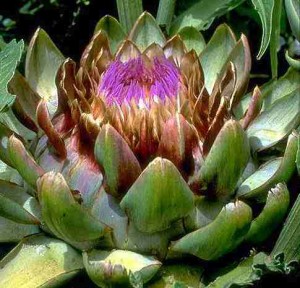
|
|
Artichoke (Cynara
scolymus)
|
Artichoke (Cynara scolymus)
Though it looks very much like a thistle and indeed has prickly elements like a
thistle, the thistle-like artichoke is in fact a member of the daisy
family. A Mediterranean plant, the artichoke, sometimes known as globe
artichoke, produces large flowers that people love to eat. The artichoke grows
tall, from 3 to 5 feet, with long lavish gray green leaves and tall stalks on top of which burst the spiky
flowers. If allowed to bloom the top of the choke erupts in purple-pink
glory.
According to an Aegean legend and praised in song by the poet Quintus Horatius
Flaccus, the first artichoke was a lovely young girl who lived on the island of
Zinari. The god, Zenus, who was jealour of her beauty, hurtled a thunderbolt towards Earth and transformed the recently elevated Goddess Cynara into an
artichoke.
It origin dates back to the time of the Greek philosopher and naturalist, Theophrastus (371-287
B.C.), who wrote of them being grown in Italy and Sicily and was known to both the Greeks and the
Romans. Dioscordes, a Greek physician, wrote about them at the time of
Christ. Ancient Greeks and Romans considered artichokes a delicacy and an
aphrodistiac. In Ancient Greece, the artichoke was attributed to being effective in securing the birth of
boys. In 77 AD the Roman naturalist Pliny called the choke one of the earth's
monstrosities, but evidently he and his colleagues continued to enjoy eating
them. One reads that wealthy Romans enjoyed artichokes prepared in honey and
vinegar, seasoned with cumin, so that the treat would be available year
round.
North African Moors begin cultivating artichokes in the area of Granada,
Spain, beginning about 800 AD, and another Arab group, the Saracens, became identified with chokes in
Sicily. Artichokes were first cultivated at Naples around the middle of the 15th century and gradually spread to other sections of
Europe.
The artichoke was introduced into England in 1548 but apparently didn't make a huge splash there nor anywhere else except
Italy, France and a few other southern European locations.
In the 16th century, Catherine de
Medici, married to King Henry II of France at the age of 14, is credited with making artichokes
famous. She is said to have introduced them to France when she married King Henry II in the mid 16th
century. She was quoted as sayig, "If one of us had eaten artichokes, we would have been pointed out on the
street. Today young women are more forward than pages at the court."
In the 16th Century eating an artichoke would be a scandalous adventure for any
woman. At that time, because the artichoke was considered an aphrodisiac, it was reserved for men
only. In fact, the artichoke was denied to women and reserved for men because it was thought to enhance sexual
power. Fortunately such esoteric attitudes do not prevail in the 21st Century where both men and women are privy to the pleasures of the
artichoke. However, there are places around the world where people have neither tasted nor seen the
artichoke.
French immigrants of Louisiana, and Spanish settlers of California brought the artichoke there in the 1600's but it didn't appear to take hold beyond individual gardens until its reintroduction in the 1920's.
In 1922 Andrew Molera, a landowner in the Salinas Valley of Monterey
County, California, just south of San Francisco, decided to lease land previously dedicated to the growing of sugar beets to farmers willing to try the
"new" vegetable. His reasons were economic-already artichokes were fetching high prices and farmers could pay Molera triple what the sugar company did for the same
land. By 1929 artichokes were the third largest cash crop in the Valley.
In the 1920s, Ciro Terranova
"Whitey" (1889-1938), a member of the mafia and known as the "Artichoke
King," began his monopoly of the artichoke market by purchasing all the produce shipped to New York from California at $6 a
crate. He created a produce company and resold the artichokes at 30 to 40 percent
profit. Not only did he terrorize distributors and produce merchants, he even launched an attack on the artichoke fields from Montara to
Pescadero, hacking down the plants with machetes in the dead of night. These
"artichoke wars" led the Mayor or New York, Fiorello La Guardia, to declare
"the sale, display, and possession" of artichokes in New York illegal. Mayor La Guardia publicly admitted that he himself loved the vegetable and after only one week he lifted the
ban.
Source:
http://www.hungrymonster.com/FoodFacts/
Food_Facts.cfm?Phrase_vch=Artichokes&fid=5952
http://www.whatscookingamerica.net/History/ArtichokeHistory.htm
http://www.vegparadise.com/highestperch48.html
